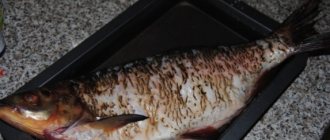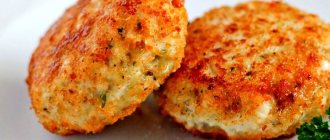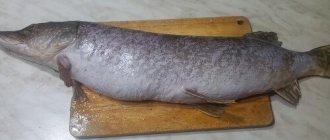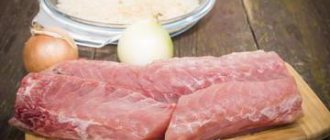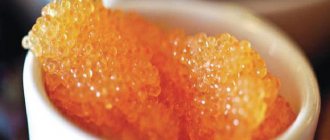Preparing the fish
Before salting, the carcass must be properly prepared. It is desirable that the carp be fresh, ideally caught with your own hands. Large carp need to be gutted, head, gills and tail removed, scaled and mucus removed. When removing the insides, it is important not to damage the gallbladder.
Fish caught with your own hands should be cut immediately in the summer. To prevent the carp from spoiling while the fishing process is in progress, you need to put nettles in the container with the fish. In winter, it is cut up upon arrival home with the catch.
Storing dried carp
Such fish, unfortunately, quickly spoils, but if certain techniques are followed, it can be stored from six months to 12 months:
- Before use, it is necessary to keep it in a dark, closed room, the humidity of which should not be lower than 65%, but not higher than 80;
- if the humidity is too low, the fish will dry out, and if it is too high, it will become moldy.
How to extend the period of consumption of dried carp:
- wrap each carcass in paper;
- place in a closed glass bottle;
- send to the previously designated place.
It can also be stored in the freezer by placing the fish in vacuum packaging.
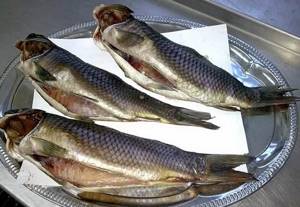
Dried fish is stored in paper
Dry salting
For salting you will need coarse salt or sea salt. Small and iodized ones are not suitable. It is best to use grind number 3, or, as a last resort, grind number 1.
In addition to salt, you can use other seasonings, for example, a mixture of peppers and bay leaves.
For dry, choose a container that has slits so that the liquid can drain. This could be a wooden box, barrel or basket. The bottom of the container is covered with burlap or cotton cloth. The fish are laid in rows - head to tail, belly up - and each layer is sprinkled with salt. Do not put salt inside the gutted carcasses, otherwise you may oversalt them. The carp are covered with a wooden lid, a weight (stone) is placed on top so that there are no cavities with air in the flesh of the fish, and they are put in a cold place. For 10 kg of fish you will need one and a half kilograms of salt. Salting time depends on the weight of the carp. You can determine readiness by the elasticity of the pulp. On average it will take about 10 days. This method is used mainly in the warm season.
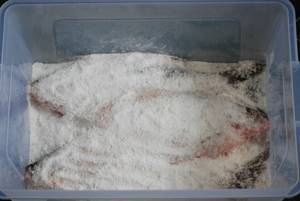
Fishermen came up with the idea of salting fish in bags buried a meter deep in the ground.
Wet pickling
Dishes for wet salting fish should not oxidize. This can be a glass or plastic container: a tank, a saucepan, a bucket, etc. Containers made of technical plastic are not suitable. Carp are placed in a container with their bellies up, sprinkled with salt at the rate of 1 kg of salt per 10 kg of fish. Salt can be mixed with a tablespoon of sugar to make the taste of the fish more delicate. A wooden circle is placed on the fish, and a weight is placed on it. You can use a flat plate, a lid from a pan, etc. as a lid. A brine begins to form in the container, and after one or two days it completely covers the fish carcasses.
There is another way to salt carp using the wet method. Prepare brine from water and salt, pour this brine over the carcasses, cover the top with a lid and set the pressure. This option is better suited for smaller fish than for large carp.
The classic way to prepare carp balyk
This recipe allows you to prepare tender and flavorful balyk. The technology looks like this step by step:
- carcass preparation;
- salting;
- drying.
After cleaning, the fish needs to be cut. This way it will salt quickly and evenly. Next, prepare a mixture of salt, sugar and spices. Rub the carcass thoroughly with it. Place the fillet in a container and place it under pressure. Place everything in the refrigerator and leave for 5-7 days.
Features of drying
Before drying, be sure to soak the carp, otherwise the balyk will turn out too salty. It will take about 4-5 hours to remove excess salt and spices. After this, the fish is wiped with napkins.
Now let's start drying:
- Each piece is tied with rope.
- The fish is hung in a well-ventilated place, but not in direct sunlight.
- 3-4 days after the start of drying, the fish is sent under oppression for another 5-7 days. This will make its surface beautiful and shiny.
- After the specified period, the carp is again hung out for drying.
The total duration of drying is from 12 to 15 days. The longer the carp is exposed to airing, the drier the balyk will be at home.
Washing and soaking
After salting, rinse with cold tap water, then soak for several hours to rid the fish of excess salt. The time is determined as follows: for one day of salting - an hour of soaking. Depending on personal taste, the time can be changed.

After the fish has been thoroughly washed under running water, it is rinsed in the sink. Change the water after each rinse until it is clean.
When the fish is soaked for several hours, the water needs to be changed periodically. The more fish, the more water there should be.
After washing, you can roll the fish in salt mixed with aspirin, the amount of which is 2% of the amount of salt.
New Year's carp balyk
This recipe makes the perfect New Year's treat at home. For cooking you will need fish caught in the fall. She's the fattest. The drying period is more than 2 months, so the product will be ready just in time for the New Year. According to the recipe you need:
- carp – 4-5 kg;
- salt – 1 kg;
- sugar – 1 tbsp. without slide;
- hot pepper – 1 tsp;
- spices – 1.5 tsp.
Of all the fish, carp is one of the budget options, so a home-cooked product will not require much expense.
Cooking features
The fish is cooked whole. After cleaning you must:
- Rub the inside of the carp with sugar;
- Cover the surface of the carcass evenly with a mixture of salt and spices.
- We pack the fish in a plastic bag and tie it with rope.
- Place the bag of fish in the refrigerator for 2-3 days.
- Wash the carp thoroughly under running water.
- Wipe the surface with a paper towel or napkins.
- We pack the fish again in a bag and tie it with a rope.
- We put the carp balyk in the refrigerator for another 2-3 months to ripen.
After the specified period, the carp can be eaten. It is served in sliced pieces. Sandwiches and snacks with dried fish look original. The aroma and taste of homemade dishes will delight everyone.
How to dry fish at home
After the fish has been soaked, it is hung to dry in the shade in a draft. It is better to dry the carp in the open air, protecting it from flies and other insects with a net or gauze. Carcasses should hang under a canopy to prevent precipitation from falling on them. The best time for drying outside is spring and autumn, when there are no flies.
In winter, you can dry fish in your apartment by setting up a special place in the kitchen for this.
At different times of the year, carp will dry differently.
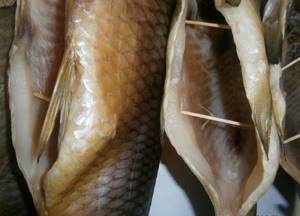
In the summer, you can set up a dryer in the garage by stringing ropes and hanging carcasses. A draft can be provided using a fan. If the fish is to be dried outdoors, it is best to hang it in the evening, when there are no more flies. The next morning the fish will “grab” and insects will no longer land on it.
In winter, it is impossible to dry fish outside, so you will have to do it at home. It is best to choose a place near a window and a heating radiator. The carcasses are hung by the tail (so that excess salt ends up in the head) on paper clips with insulation. They should not touch each other, otherwise they will not dry well.
The duration of carp drying depends on many things: time of year, conditions (indoors, open air), climate, weather conditions, size of the fish.
The condition to which the fish is brought depends on individual taste. Some people like it drier, others under-dried, so the surest way to determine readiness is to take samples. On average, carp takes two to three weeks to dry.
Methods for salting and drying carp
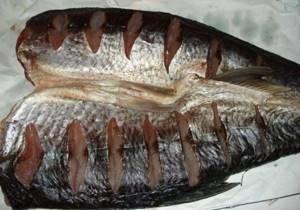
The most popular methods of drying carp are drying them in an electric dryer or in the open air, if the weather permits (precipitation should not fall on the food). If this is cooking at home, then it is best to use the oven. The first two options are good because they allow the fish to be nourished and dry well, and remove excess moisture. In the open air, when the rays hit the carp, fat is released, which gives it an external shine and adds richness of taste.
How to properly cook dried fish in the oven

To prepare carp, the traditional method of salting in layers is used. Place the product in a container and cover with a heavy object for a day. After this, rinse the fish and dry it with dry towels. Make thin cuts on the carp so that it turns out dried, and not boiled or steamed.
Place the fish on a baking sheet previously covered with parchment paper and place in the oven. Simmer the fish with the door open and a temperature of 40 degrees for about 7-8 hours, depending on the size of the fish. After cooking, the carp is “ventilated” in the open air for 24 hours.

Cooking time depends on the size of the fish
Due to the low temperature and the slightly open door, moisture escapes and the fish dries. The disadvantages of this method are high energy consumption and insufficiently rich taste. This method of drying allows you to prepare your favorite dish at home.
On open air
This method involves two stages: the first is salting, the second is simmering in the open air. The first stage is carried out in the same way as in other methods, but 4-15 days are allotted for salting, depending on the weight of the fish.
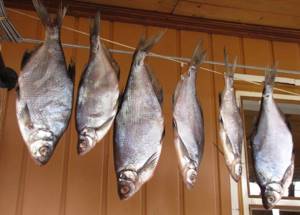
It is advisable to hang fish away from prying hands and claws
After drying, the fish is strung on thin twine or rope through the eye holes and suspended from the rope in the open air. Due to the wind and sun, moisture is removed and the fish is dried. The best time for this method is March-April or the end of October, when flies or insects have not spoiled the food - this is a disadvantage of the method. Cover the fish with gauze and leave for 14 days.
In an electric dryer
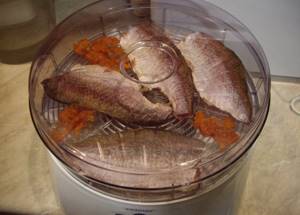
Using the salting method, prepare the carp for drying by cutting it along the ridge. Then you should turn on an electric dryer, for example, VOLTERA 1000 Lux, and lay out the fish in layers and dry at a temperature of 55-60 degrees. Due to the heating of the fish by the air flow from the hot heating element. When the carp is ready, hang it in the open air. This method allows you to cook fish quickly and without much effort, but you should be prepared for the fact that the dryer may not be sufficiently powerful and may not dry the fish.
After the fish is cooked, you need to place it in a cool and dark place. The carp is hung on a rope, wrapped in paper, or left in a tin jar with a tight-fitting lid. The finished product is stored for about 6 -12 months. It is used in salads, sandwiches or as an independent dish. Carp adds a special taste to the dish, making the food interesting and unusual.
On the site you can also read an article about drying ram at home.



